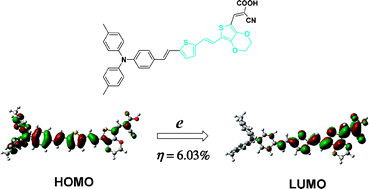Molecular design of triarylamine-based organic dyes for efficient dye-sensitized solar cells
Abstract
Three donor–(π-spacer)–acceptor

* Corresponding authors
a
Beijing National Laboratory for Molecular Sciences (BNLMS), Laboratory of New Materials, State Key Laboratory for Structural Chemistry of Unstable and Stable Species, Institute of Chemistry, Chinese Academy of Sciences, Beijing, P. R. China
E-mail:
yanglm@iccas.ac.cn, kjjiang@iccas.ac.cn
Fax: +86-10-62559373
Tel: +86-10-62565609
b Graduate School of Chinese Academy of Sciences, Beijing, P. R. China
Three donor–(π-spacer)–acceptor

 Please wait while we load your content...
Something went wrong. Try again?
Please wait while we load your content...
Something went wrong. Try again?
G. Li, K. Jiang, P. Bao, Y. Li, S. Li and L. Yang, New J. Chem., 2009, 33, 868 DOI: 10.1039/B815649B
To request permission to reproduce material from this article, please go to the Copyright Clearance Center request page.
If you are an author contributing to an RSC publication, you do not need to request permission provided correct acknowledgement is given.
If you are the author of this article, you do not need to request permission to reproduce figures and diagrams provided correct acknowledgement is given. If you want to reproduce the whole article in a third-party publication (excluding your thesis/dissertation for which permission is not required) please go to the Copyright Clearance Center request page.
Read more about how to correctly acknowledge RSC content.
 Fetching data from CrossRef.
Fetching data from CrossRef.
This may take some time to load.
Loading related content
